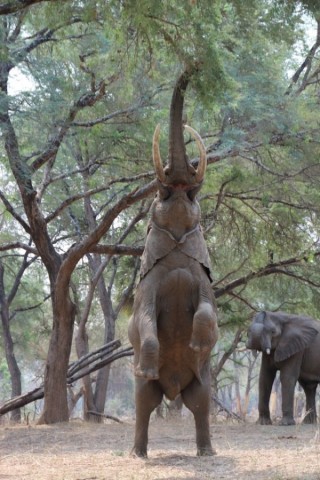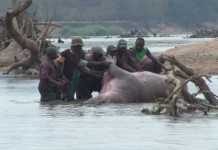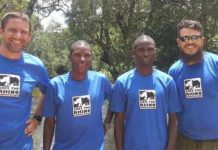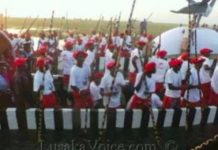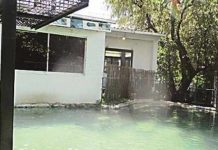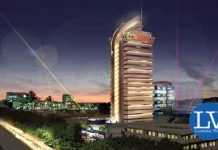You can travel the world, but you will never encounter the pure wild isolation of the great national parks in Zambia. One of these vast unfenced reserves is the Lower Zambezi National Park on the Zambezi River. I decided to chat to some of the heroes working to conserve this patch of paradise, to find out more about the reserve and what it’s like to live and work in this amazing wilderness.
Conservation Lower Zambezi is an NGO working on the ground in the park. This team works directly with the Zambia Wildlife Authority (ZAWA) who manage the park. support comes in the form of providing rations, transport, communications, equipment, logistics and advice to ZAWA wildlife protection officers carrying out patrols to enable them to conduct long patrols and reach even remote areas of the park. CLZ also equipped and trained and are now sponsoring and co-managing a team of 15 Village Scouts, employed through the Community Resource Board, who provide extra human resources to ZAWA. I chatted to General Manager Eleanor Harvie to find out more.
The Lower Zambezi National Park measures 4,092 square kilometers and is surrounded by three Game Management Areas (GMAs): Luano in the North, Rufunsa to the East and the Chiawa GMA to the West. These GMAs together add 14,453 square kilometers of protected wildlife area to the Lower Zambezi National Park. All in all, a total of 1.85-million hectares.
It is obvious that tourism is a massive revenue earner for the Lower Zambezi National Park, creating jobs for the locals and generally helping the reserve to pay it’s way. I chatted to Tim Featherby, owner of Baines River Camp, about some of the highs and lows of operating a safari lodge in such an isolated area.
How long have you been running a lodge in the Lower Zambezi area?
We bought an existing camp at the end of 2004 and commenced the full overhaul/revamp in March 2005, starting with the “back-of-house” facilities: staff accommodation, workshop, generator housing’ water towers and lodge kitchen and laundry. We finally finished this in August 2010. So, having owned the company since December 2004, we started to commercially run Baines’ River Camp about 3 years ago, towards the end of the 2010 season.
What are some of the challenges about running a lodge in such an isolated place?
The beauty of being in such an isolated area, with no main power supply, telephone lines, fences, is the absence of light and noise pollution and the fact that wild animals felt comfortable enough to make our camp their home. Some of them, especially elephants, warthogs, porcupines and baboons, can cause some frustrations in daily operations and gardening, but we keep reminding ourselves that we are actually the invasive aliens! There are two main challenges. Firstly, logistics. You guessed that right! All our supplies are sourced in Lusaka and even though the Zambian capital is only about 120 km from our camp as the crow flies, on a good day, it takes four and a half hours by road to get there.
Secondly, there is the challenge of finding managers who are happy to be in this isolated environment for long periods. All our staff live on site and the majority of the team comes from the local villages on the banks of the Zambezi. They are more or less used to this environment and go home for a week every 6 weeks. Management however, has to be sourced in general from the cities and stay on site most of the season. Our manageress Debbie, for instance, doesn’t get to see the city lights for 3 months on end! In terms of both these challenges, the relationship with other safari camps in the area is immensely important.
How do you assist with the conservation of the area? Do you have ties with CLZ?
In the past, we had to privately engage with ZAWA and a local wildlife veterinarian on a regular basis in rescue operations, always involving elephants, injured by either snares or rifles. It always left us wondering how many animals were not strong enough to pull free and survive. Over the years, Conservation Lower Zambezi’s hard work and efforts have resulted in commendable achievements. Although not completely eradicated, the poaching activities in the Lower Zambezi Valley seem to have diminished substantially and it is only logical that we support CLZ financially by way of a Platinum membership and by being actively involved on its board. Obviously, the National Park takes priority over the game management areas (GMAs) in terms of ZAWA’s distribution of manpower and funding.
Baines’ River Camp is situated in the Eastern Chiawa GMA, a buffer zone to the Lower Zambezi National Park. To be successful in preserving the GMA’s wildlife and environment, we need the support, commitment and involvement of the local communities. To this end, the community needs to see tangible benefits from the safari tourism and we are committed to establishing the Chiawa Partnership Park whereby our GMA is run by the safari operators, the local community and ZAWA in partnership. Once the legal framework for this has been established, we can fully focus on this project.
What do you personally love about the Lower Zambezi National park?
There are four things that I truly love about the Lower Zambezi Valley specifically. Firstly, the river itself. Flowing water is always mesmerizing and the sheer expanse of the Zambezi is simply overwhelming. Flowing West to East where we are, the river offers the most incredible sunrises and sunsets and most importantly, guests can view wildlife from motorized boats and canoes in addition to game drives and walking safaris.
Secondly, the Elephants. They are without a doubt my favorite wild animal and there is an abundance of these majestic creatures in the Lower Zambezi Valley. We haven’t been given the results of the most recent census, but CLZ seems confident that elephant numbers in the Valley have increased over the last few years. Thirdly, the uncontrived game viewing in the Park without traversing right restrictions. We generally take guests on game drives from around 6 AM until 1PM. During a full morning out we will encounter at most 3 other game viewing vehicles and the sounds of the bush are only seldom interrupted by crackling radios. It makes a game drive an experience rather than a race to see a lion or a leopard. We can only thank the guides in the Valley and their mentors for setting high standards, using radios only when necessary and respecting wildlife, the environment and other visitors.
Lastly, and certainly not least of all, the diversity of vegetation of the Valley. Driving through the National Park and Game Management Area, you will go through pockets of different vegetation ranging from thick miombo and shrubs to Albida forests and Palm groves to grassland, riverine forests. Each pocket attracts different birds and wildlife.

 JOIN DRIVERN TAXI AS PARTNER DRIVER TODAY!
JOIN DRIVERN TAXI AS PARTNER DRIVER TODAY!